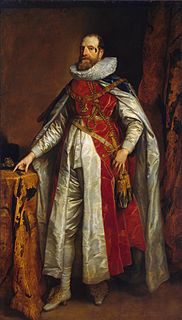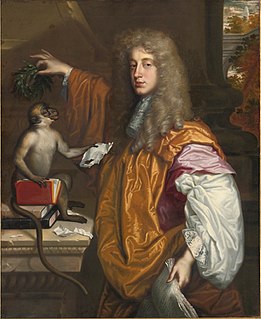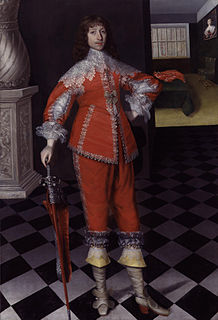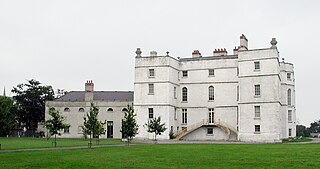Related Research Articles

Marquess of Normanby is a title that has been created twice, once in the Peerage of England and once in the Peerage of the United Kingdom. The first creation came in 1694 in the Peerage of England in favour of John Sheffield, 3rd Earl of Mulgrave. He was a notable Tory politician of the late Stuart period, who served under Queen Anne as Lord Privy Seal and Lord President of the Council. In 1703 this first Marquess of Normanby was further honoured when he was made Duke of Buckingham and Normanby. These titles became extinct on the death of the 2nd Duke in 1735.

Earl of Suffolk is a title which has been created four times in the Peerage of England. The first creation, in tandem with the creation of the title of Earl of Norfolk, came before 1069 in favour of Ralph the Staller; but the title was forfeited by his heir, Ralph de Guader, in 1074. The second creation came in 1337 in favour of Robert de Ufford; the title became extinct on the death of his son, the second Earl, in 1382. The third creation came in 1385 in favour of Michael de la Pole. The fourth creation was in 1603 for Lord Thomas Howard, the second son of Thomas Howard, 4th Duke of Norfolk, by his second wife Margaret Audley, the daughter and eventual sole heiress of Thomas Audley, 1st Baron Audley of Walden, of Audley End in the parish of Saffron Walden in Essex. Howard was a prominent naval commander and politician and served as Earl Marshal, as Lord Chamberlain of the Household and as Lord High Treasurer. In 1597 he was summoned to Parliament as Baron Howard de Walden, and in 1603 he was further honoured, at the start of the reign of King James I, when he was created Earl of Suffolk. His second son the Hon. Thomas Howard was created Earl of Berkshire in 1626.

Earl of Halifax is a title that has been created four times in British history—once in the Peerage of England, twice in the Peerage of Great Britain, and once in the Peerage of the United Kingdom. The name of the peerage refers to Halifax, West Yorkshire.

Baron Dacre is a title that has been created three times in the Peerage of England, every time by writ.

Baron Strange is a title which has been created four times in the Peerage of England. Two creations, one in 1295 and another in 1326, had only one holder each, upon whose deaths they became extinct. Two of the creations, that of 1299 and that of 1628, are extant. The surname Le Strange was Latinized as Extraneus. The arms of Le Strange of Knockin Castle in Shropshire were: Gules, two lions passant argent.

Earl of Lisburne is a title in the Peerage of Ireland. It was created in 1776 for Wilmot Vaughan, 4th Viscount Lisburne. He represented Cardiganshire and Berwick-upon-Tweed in the House of Commons and held minor governmental office.

Viscount Galway is a title that has been created once in the Peerage of England and thrice in the Peerage of Ireland. The first creation came in the Peerage of England in 1628 in favour of Richard Burke, 4th Earl of Clanricarde. He was made Earl of St Albans at the same time. The second creation came in the Peerage of Ireland in 1687 in favour of Ulick Bourke. He was made Baron Tyaquin at the same time, also in the Peerage of Ireland. However, both titles became extinct on his early death in 1691. The third creation came in the Peerage of Ireland in 1692 in favour of the French soldier and diplomat Henry de Massue, Marquis de Ruvigny, who was created Baron Portarlington, also in the Peerage of Ireland, at the same time. He was made Earl of Galway in 1697. However, both titles became extinct on his death in 1720.

Earl of Danby was a title that was created twice in the Peerage of England. The first creation came in 1626 in favour of the soldier Henry Danvers, 1st Baron Danvers. He had already been created Baron Danvers, of Dauntsey in the County of Wiltshire, in 1603, also in the Peerage of England. The titles became extinct on his death in 1644. The second creation came in 1674 in favour of Thomas Osborne, 1st Viscount Latimer. He was the son of Anne, daughter of Thomas Walmesley and Eleanor Danvers, sister of the first Earl of the first creation. For more information on the second creation, see Duke of Leeds.

Earl of Yarmouth is a title that has been created three times in British history, once in the Peerage of England and twice in the Peerage of Great Britain. The first creation came in the Peerage of England in 1679 in favour of the politician and scientist Robert Paston, 1st Viscount Yarmouth. He had already been created Baron Paston and Viscount Yarmouth in the Peerage of England in 1673. He was the son of William Paston, who had been created a Baronet, of Oxnead in the County of Norfolk, in the Baronetage of England in 1641. Lord Yarmouth was succeeded by his son, the second Earl. He notably served as Treasurer of the Household between 1687 and 1689. He had no surviving male issue and the titles became extinct on his death in 1732.

Earl of Londonderry is a title that has been created three times in the Peerage of Ireland. The first creation came in 1622 in favour of Thomas Ridgeway, 1st Baron Ridgeway, who served as Treasurer of Ireland and was involved in the colonisation of Ulster. He had already been created a Baronet, of Torrington in the County of Devon, in 1611, Lord Ridgeway, Baron of Gallen-Ridgeway, in the Peerage of Ireland, in 1616, and was made Viscount Gallen-Ridgeway at the same time as he was granted the earldom, also in the Peerage of Ireland. The titles became extinct on the death of his great-grandson, the fourth Earl, in 1714.

Baron Keith was a title that was created three times in British history, with all three creations in favour of the same person, Admiral the Honourable Sir George Keith Elphinstone. He was the fifth son of Charles Elphinstone, 10th Lord Elphinstone by his wife Lady Clementine, daughter of John Fleming, 6th Earl of Wigtown and Lady Mary, daughter of William Keith, 8th Earl Marischal. The first creation came in the Peerage of Ireland in 1797 when he was made Baron Keith, of Stonehaven Marrischal, with remainder in default of issue male of his own to his daughter and only child from his first marriage, Margaret Mercer Elphinstone, and the heirs male of her body. On 15 December 1801 he was created Baron Keith, of Stonehaven Marischal in the County of Kincardine, in the Peerage of the United Kingdom, with normal remainder to heirs male. In 1803 he was made Baron Keith, of Banheath in the County of Dumbarton, in the Peerage of the United Kingdom, with remainder to his daughter and only child from his first marriage, Margaret Mercer Elphinstone and the heirs male of her body. In 1814 Lord Keith was further honoured when he was made Viscount Keith in the Peerage of the United Kingdom, with normal remainder to heirs male.

Earl of Rochester is a title that was created twice in the Peerage of England. The first creation came in 1652 in favour of the Royalist soldier Henry Wilmot, 2nd Viscount Wilmot. He had already been created Baron Wilmot, of Adderbury in the County of Oxford, in 1643, also in the Peerage of England. He was the son of Charles Wilmot, who had been elevated to the Peerage of Ireland as Viscount Wilmot, of Athlone, in 1622. Lord Rochester died in 1658 and was succeeded by his son John Wilmot, 2nd Earl of Rochester. He was a poet, a friend of King Charles II, and the writer of satirical and bawdy poetry. He married the heiress Elizabeth Malet. He was succeeded on his death in 1680 by his only son, the third Earl. He died at a young age the following year, when the titles became extinct.
Baron Nugent is a title that has been created three times, twice in the Peerage of Ireland and once in the Peerage of the United Kingdom. All three creations are extinct. The first creation came in the Peerage of Ireland in 1767 in favour of Robert Craggs-Nugent, who was made Viscount Clare at the same time. In 1776 he was further honoured when he was made Earl Nugent. For further history of this creation, see Earl Nugent and Viscount Cobham. The second creation came in the Peerage of Ireland in 1800 when Mary, Marchioness of Buckingham, was made Baroness Nugent, of Carlanstown in the county of Westmeath, with remainder to her second son Lord George Nugent-Grenville. She was the daughter of the first Earl Nugent and the wife of George Nugent-Temple-Grenville, 1st Marquess of Buckingham. She was succeeded according to the special remainder by her younger son, Lord George, the second Baron. The title became extinct on his death in 1850. The third creation came in the Peerage of the United Kingdom on 22 August 1960 when Terence Nugent was made Baron Nugent, of West Harling in the county of Norfolk. This creation became extinct on his death in 1973.

Earl of Norwich was a title that was created four times in British history, three times in the Peerage of England and once in the Peerage of Great Britain. The first creation came in the Peerage of England in 1626 in favour of the courtier and politician Edward Denny, 1st Baron Denny. He had already been created Baron Denny, of Waltham in the County of Essex, in 1604, also in the Peerage of England. Lord Norwich was the grandson of Sir Anthony Denny, confidant of Henry VIII, and the nephew of Sir Edward Denny. He had no sons and the titles became extinct on his death in 1630.
Viscount Loftus is a title that has been created three times in the Peerage of Ireland for members of the Anglo-Irish Loftus family. The first creation was for Adam Loftus on 10 May 1622, who served as Lord Chancellor of Ireland in 1619. This title became extinct in 1725 upon the death of the third viscount. The second creation was for Nicholas Loftus in 1756, a great-grandson of Adam and a member of the Irish House of Commons. Two of his sons were created earls as Earl of Ely, although both titles became extinct. The third creation of the title was for Charles Loftus in 1789, who became Marquess of Ely in 1800. This title is extant.
Viscount Lanesborough is a title that has been created twice in the Peerage of Ireland. The first creation came on 31 July 1676 in favour Sir George Lane, 2nd Baronet. The titles became extinct upon the death of his son, the second Viscount, on 2 August 1724. The Lane Baronetcy, of Tulske in the County of Roscommon, had been created in the Baronetage of Ireland on 9 February 1661 for Richard Lane. The second creation came on 12 August 1728 in favour Brinsley Butler, 2nd Baron Newtown-Butler. His son Humphrey was created Earl of Lanesborough in 1756. See the latter title for more information on this creation.
Viscount Decies is a title that has been created twice in the Peerage of Ireland. The first creation came on 31 January 1569 in favour Maurice Fitzgerald, Baron of Dromana. He had already been created Baron of Dromana on 27 January 1569, also in the Peerage of Ireland. This creation became extinct on his death in 1572. The second creation came on 9 October 1673 in favour of Richard Power, 6th Baron Power. See Earl of Tyrone for more information on this creation.
Viscount Mount Cashell was a title that was created twice in the Peerage of Ireland. The first creation came in 1706 in favour of Paul Davys. He was made Baron Mount Cashell at the same time, also in the Peerage of Ireland. The titles became extinct on the death of the third Viscount in 1736. The second creation came in 1766 in favour of Stephen Moore. For more information on this creation, see Earl Mount Cashell.

Baron Belasyse was a title that was created twice in the Peerage of England. The first creation came on 27 January 1645 when the Honourable John Belasyse was made Baron Belasyse of Worlaby in the County of Lincoln. He was the second son of Thomas Belasyse, 1st Viscount Fauconberg, the younger brother of the Honourable Henry Belasyse and the uncle of Thomas Belasyse, 1st Earl Fauconberg. He was succeeded by his grandson, Henry, the second Baron, the son of Sir Henry Belasyse, who was killed in a duel in 1667. The title became extinct when the second Baron died childless in 1691.

Adam Loftus, 1st Viscount Lisburne was an Anglo-Irish peer and military commander.